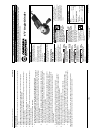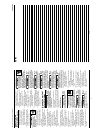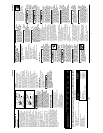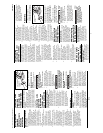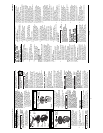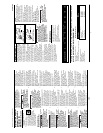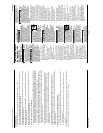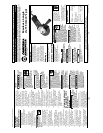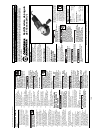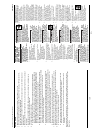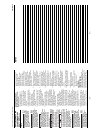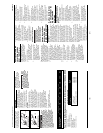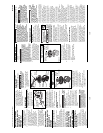
Instrucciones de
Seguridad
Adicionales para
Trabajos de Lijado
ADVERTENCIAS DE SEGURIDAD
ESPECÍFICAS PARA LOS TRABAJOS
DE LIJADO:
Para lijar, evite el uso de discos de
papel de lija de tamaño excesivo.
Cuando selecciona el papel de lija, siga
las recomendaciones del fabricante. El
papel de lija demasiado grande que se
extiende por fuera de la almohadilla de
soporte presenta el riesgo de romperse
y puede causar atascos, rotura del disco
o contragolpes.
Instrucciones de
Seguridad
Adicionales para
Trabajos con el
Cepillo de Alambre
ADVERTENCIAS DE SEGURIDAD
ESPECÍFICAS PARA LOS TRABAJOS
CON CEPILLO DE ALAMBRE:
1. Tenga en cuenta que unas cerdas de
alambre pueden desprenderse del
cepillo durante el funcionamiento
normal. No fuerce los alambres
excesivamente aplicando demasiada
presión sobre el cepillo. Las cerdas
de alambre pueden penetrar
fácilmente ropa liviana y/o la piel.
2. Si se recomienda el uso de un
protector para los trabajos con el
cepillo de alambre, no permita
ningún contacto entre la rueda de
alambre o el cepillo y el protector.
La rueda de alambre o el cepillo
pueden aumentar el diámetro
debido a la presión aplicada y las
fuerzas centrífugas.
Ensamblaje
INSTALACIÓN DEL MANGO
LATERAL
1. DESENCHUFE LA RECTIFICADORA.
2. INSTALE EL MANGO LATERAL
ATORNILLÁNDOLO AL COSTADO
DE LA CAJA DE ENGRANAJES.
Nota: el mango se puede instalar
del lado derecho o izquierdo de la
rectificadora, según la preferencia del
operador. EL MANGO LATERAL DEBE
USARSE SIEMPRE PARA EVITAR LA
PÉRDIDA DE CONTROL Y POSIBLES
LESIONES GRAVES.
Instrucciones de
Seguridad
Adicionales para
Trabajos de
Rectificación
ADVERTENCIAS DE SEGURIDAD
ESPECÍFICAS PARA LOS TRABAJOS
DE RECTIFICACIÓN:
1. Use siempre los protectores
diseñados para el tipo de rueda que
está empleando. El protector debe
estar firmemente sujetado a la
herramienta eléctrica y en la
posición de máxima seguridad, de
tal manera que la menor parte
posible de la rueda quede expuesta
hacia el operador. El protector
ayuda a proteger el operador de
fragmentos de una rueda dañada y
del contacto accidental con la
rueda.
2. Use sólo los tipos de rueda
recomendados para su herramienta
eléctrica y el protector
especialmente diseñado para la
rueda seleccionada. Las ruedas
diseñadas para una herramienta
eléctrica diferente no permiten el
uso adecuado del protector y son
peligrosas.
3. Las ruedas deben usarse sólo para
las aplicaciones recomendadas. Por
ejemplo: no haga trabajos de
rectificación usando la cara de una
hoja de corte. Las hojas de corte
abrasivas están diseñadas para
rectificación periférica: el aplicar
fuerzas laterales a estas ruedas
puede causar que se quiebren.
4. Use siempre bridas sin daños y del
tamaño y forma correctos para la
rueda seleccionada. Las bridas
apropiadas proporcionan buen
soporte limitando así la posibilidad
de que la rueda de quiebre. Las
bridas para las ruedas de corte
pueden ser diferentes de las bridas
para las ruedas rectificadoras.
5. No use ruedas desgastadas aptas
para herramientas eléctricas de
tamaño más grande. Las ruedas
diseñadas para herramientas
eléctricas más grandes no son aptas
para la velocidad más elevada de
una herramienta más pequeña y
pueden estallar.
Figura 1
El botón de
bloqueo del
vástago
Manual de Instrucciones y Lista de Piezas
24 Sp
3. Ajuste el mango lateral de modo
seguro.
INSTALACIÓN DE LA RUEDA
ABRASIVA
Se proporciona una protección para
la rueda con la herramienta.
Utilice siempre una protección
aprobada y correctamente ajustada
para la rueda cuando use esta
herramienta.
1. DESENCHUFE LA RECTIFICADORA.
2. Coloque la herramienta dada
vuelta con el vástago hacia arriba.
3. Coloque la protección en el reborde
de montaje. Gire la protección
hasta una posición que ubique la
protección entre el operador y la
rueda abrasiva. Ajuste el tornillo
de fijación para asegurar
la protección en la posición
correcta.
Asegúrese siempre de que la protección
de la rueda esté entre el operador y la
rueda, de modo que las lascas o trozos
de rueda que se puedan desprender
sean desviados lejos del operador.
INSTALACIÓN DE LAS RUEDAS
ACCESORIAS
1. DESENCHUFE LA RECTIFICADORA.
No desenchufar la rectificadora puede
hacer que se encienda accidentalmente
causando lesiones graves.
2. Su rectificadora se envía con el
reborde del disco y la tuerca de
sujeción conectados al vástago
(ver Figuras 2 y 3).
3. Presione el botón de bloqueo del
vástago y gire la tuerca de sujeción
hasta que se bloquee el vástago
(ver Figura 1). Para evitar dañar el
vástago o el bloqueo del vástago,
siempre deje que el motor se
detenga por completo antes de
enganchar el bloqueo del vástago.
Further Safety
Instructions For All
Operations (Cont.)
power tool to be forced in the
direction opposite of the accessory’s
rotation at the point of the binding.
For example, if an abrasive wheel is
snagged or pinched by the workpiece,
the edge of the wheel that is entering
into the pinch point can dig into the
surface of the material causing the
wheel to climb out or kick out. The
wheel may either jump toward or away
from the operator, depending on
direction of the wheel’s movement at
the point of pinching. Abrasive wheels
may also break under these conditions.
Kickback is the result of power tool
misuse and/or incorrect operating
procedures or conditions and can be
avoided by taking proper precautions
as given below.
1. Maintain a firm grip on the power
tool and position your body and
arm to allow you to resist kickback
forces. Always use auxiliary handle,
if provided, for maximum control
over kickback or torque reaction
during start-up. The operator can
control torque reactions or kickback
forces, if proper precautions are
taken.
2. Never place your hand near the
rotating accessory. Accessory may
kickback over your hand.
3. Do not position your body in the
area where power tool will move if
kickback occurs. Kickback will
propel the tool in direction
opposite to the wheel’s movement
at the point of snagging.
4. Use special care when working
corners, sharp edges etc. Avoid
bouncing and snagging the
accessory. Corners, sharp edges or
bouncing have a tendency to snag
the rotating accessory and cause
loss of control or kickback.
5. Do not attach a saw chain
woodcarving blade or toothed saw
blade. Such blades create frequent
kickback and loss of control.
Additional Safety
Instructions For
Grinding Operations
SAFETY WARNINGS SPECIFIC FOR
GRINDING OPERATIONS:
1. Always use guard designed for the
type of wheel you are using. The
guard must be securely attached to
the power tool and positioned for
maximum safety, so the least
amount of wheel is exposed
towards the operator. The guard
helps to protect operator from
broken wheel fragments and
accidental contact with wheel.
2. Use only wheel types that are
recommended for your power tool
and the specific guard designed for
the selected wheel. Wheels for
which the power tool was not
designed cannot be adequately
guarded and are unsafe.
3. Wheels must be used only for
recommended applications. For
example: do not grind with the
side of cut-off wheel. Abrasive cut-
off wheels are intended for
peripheral grinding, side forces
applied to these wheels may cause
them to shatter.
4. Always use undamaged wheel
flanges that are of correct size and
shape for your selected wheel.
Proper wheel flanges support the
wheel thus reducing the possibility
of wheel breakage. Flanges for cut-
off wheels may be different from
grinding wheel flanges.
5. Do not use worn down wheels from
larger power tools. Wheel intended
for larger power tool is not suitable
for the higher speed of a smaller
tool and may burst.
Additional Safety
Instructions For
Sanding Operations
SAFETY WARNINGS SPECIFIC FOR
SANDING OPERATIONS:
When sanding, do not use excessively
oversized sanding disc paper. Follow
manufacturers recommendations,
when selecting sanding paper. Larger
sanding paper extending beyond the
sanding pad presents a laceration
hazard and may cause snagging,
tearing of the disc, or kickback.
Additional Safety
Instructions For Wire
Brushing Operations
SAFETY WARNINGS SPECIFIC FOR
WIRE BRUSHING OPERATIONS:
1. Be aware that wire bristles are
thrown by the brush even during
ordinary operation. Do not
overstress the wires by applying
excessive load to the brush. The
wire bristles can easily penetrate
light clothing and/or skin.
2. If the use of a guard is
recommended for wire brushing, do
not allow any interference of the
wire wheel or brush with the guard.
Wire wheel or brush may expand in
diameter due to work load and
centrifugal forces.
Assembly
INSTALLING THE SIDE HANDLE
1. UNPLUG YOUR GRINDER.
2. Install the side handle by screwing
it into the side of the gear housing.
Note: The handle can be installed on
either the left or right side of the
grinder, depending on operator
preference. THE SIDE HANDLE MUST
ALWAYS BE USED TO PREVENT LOSS
OF CONTROL AND POSSIBLE SERIOUS
INJURY.
3. Tighten side handle securely.
INSTALLING THE WHEEL GUARD
A wheel guard is furnished with the
tool.
Always
use an
approved, and properly adjusted,
wheel guard when using this tool.
1. UNPLUG YOUR GRINDER.
2. Rest tool on its back with spindle
facing up.
3. Seat guard onto mounting flange.
Rotate the guard to a position that
will place the guard between the
operator and the grinding wheel.
Tighten clamp screw to secure the
guard in proper position.
Always
make
sure the wheel guard is positioned
between operator and the wheel, so
that flying chips or pieces of a wheel
that might break will be deflected
away from the operator.
5
www.chpower.com
DG470500CK
Figure 1
Spindle lock
button



